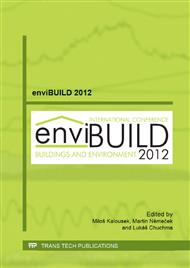p.203
p.207
p.211
p.217
p.223
p.227
p.231
p.236
p.242
Analysis of Environmental Impacts on Thermal Conductivity of Insulation Block from Secondary Raw Materials
Abstract:
Due to tightening requirements for thermal protection of buildings, the development of new materials with good thermal insulation properties is supported. Correct design of structural details leads to the elimination of thermal bridges and to the improvement of the indoor environment. Thermal conductivity of materials is not constant, is influenced by many factors. In addition to density and bulk density, structure and composition of material, it depends mainly on the humidity and temperature of the material. In the framework of sustainable construction, emphasis is placed on reduction of natural resources consumption, saving of energy and minimization of the harmful effects resulting from the processing of primary raw materials. Also one of the greatest problems of today is waste disposal. The simplest option in terms of technology and economic costs is a landfill. Many materials - in particular waste polymers - subjects to chemical changes very slowly. Therefore there is a support of the efforts to extend the product life cycle through recycling. Thermal insulating blocks made from secondary raw materials, described in this paper, are one of the solutions to this problem.
Info:
Periodical:
Pages:
223-226
Citation:
Online since:
January 2013
Authors:
Price:
Сopyright:
© 2013 Trans Tech Publications Ltd. All Rights Reserved
Share:
Citation:


